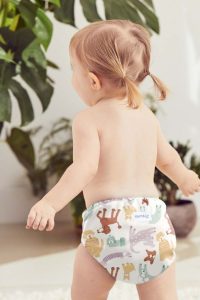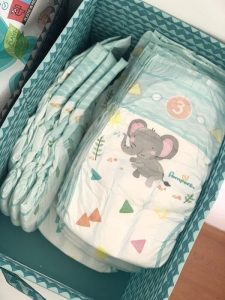Diapers have been a necessity for caregivers of young children for millennia. However, the materials and designs of diapers have changed dramatically throughout history. This article explores the fascinating evolution of diapers, from natural materials to modern disposable designs.
Ancient Beginnings
The earliest forms of diapers were likely very simple and made from readily available natural materials. Here are some examples:
Leaves and animal skins:
These were readily available materials used in many cultures for rudimentary diaper covers.
Moss and grasses:
Soft, absorbent plants were used as inner linings to capture moisture.
Cloth scraps and animal hides:
Reusable cloths or animal hides were used as absorbent layers.
Diapers Around the World
Different cultures developed their own unique diaper designs using available materials:
- China: Used silk or cloth wraps with absorbent linings made from hemp or other plants.
- Europe: Utilized cloth diapers made from linen or wool, often fastened with pins or belts.
- South America: Incorporated absorbent materials like llama wool or leaves into their diaper designs.

The Rise of Cloth Diapers
By the Middle Ages, cloth diapers became more common in Europe and North America. These diapers were typically made from:
- Linen: A strong, absorbent fabric that could be washed and reused.
- Flannel: A softer fabric used for the inner lining against the baby’s skin.
- Safety pins: Used to fasten the diaper securely around the baby.
The 20th Century and Disposable Diapers
The 20th century saw significant advancements in diaper technology. Here are some key milestones:
- Early 1900s: Mass production of cloth diapers made them more readily available.
- 1940s: Disposable diapers made from paper pulp were developed for use during World War II.
- 1960s: The invention of leak-proof materials like plastic revolutionized disposable diapers.
- Late 20th century: Disposable diapers became increasingly absorbent, comfortable, and convenient.
The Debate: Cloth vs. Disposable
Today, parents have a choice between cloth and disposable diapers. Here’s a quick comparison:
- Cloth diapers: Reusable and eco-friendly, but require washing and can be bulky.
- Disposable diapers: Convenient and hygienic, but create landfill waste.

The Future of Diapers
Diaper technology continues to evolve. Here are some trends to watch:
- Biodegradable materials: Disposable diapers made from plant-based materials that decompose faster.
- Superabsorbent polymers: Materials that can hold even more moisture for increased leak protection.
- Smart diapers: Diapers with sensors that can alert caregivers when a change is needed.
Diapers have come a long way from their simple beginnings. Today’s options offer convenience, absorbency, and comfort for both babies and caregivers. As technology continues to develop, we can expect to see even more innovative diaper designs in the future.
Innovations in Cloth Diapering
While disposable diapers have become increasingly popular in recent decades, cloth diapers remain a viable option for many parents. Here’s a look at advancements in cloth diapering technology:
- Modern Fabrics: Today’s cloth diapers often use softer, more breathable fabrics like organic cotton or bamboo against the baby’s skin.
- Pocket Diapers: These diapers have a waterproof outer shell and a separate absorbent inner liner. The liners can be disposable or made from absorbent fabrics like microfiber. This allows for easier cleaning and faster drying times.
- All-in-One (AIO) Diapers: These combine the waterproof shell and absorbent liner into a single unit. They offer convenience similar to disposable diapers but can be reused after washing.
- Diaper Sprayers: These handheld devices attach to a toilet and allow for easier cleaning of soiled cloth diapers before laundering.

Environmental Impact
Disposable diapers are convenient, but they create a significant amount of landfill waste. Cloth diapers, on the other hand, can be reused many times, reducing waste. However, the environmental impact of cloth diapers also depends on washing habits. Energy and water used for washing must be factored in.
Cost Considerations
Upfront costs for cloth diapers tend to be higher than disposable diapers. However, cloth diapers are reusable, and the cost savings can be significant over time, especially for parents with multiple children.
Deciding Between Cloth and Disposable Diapers
The choice between cloth and disposable diapers is a personal one. Here are some factors to consider:
- Lifestyle: Cloth diapers require more laundry and planning. Disposable diapers offer more convenience.
- Budget: Cloth diapers have a higher upfront cost but can save money in the long run.
- Environmental concerns: Cloth diapers create less landfill waste.

The history of diapers is a story of innovation and adaptation. From ancient civilizations to modern times, caregivers have sought ways to keep babies comfortable and clean. Today, parents have a wide range of diaper options to choose from, both disposable and reusable. With careful consideration of factors like convenience, cost, and environmental impact, parents can select the best diaper solution for their needs and lifestyle.
Cultural Traditions and Diapering Practices
Diapers are a universal need, but approaches to diapering vary around the world. Here are some interesting traditions:
- Belly Binding: In some cultures, a newborn’s belly is wrapped tightly with a cloth. This practice is believed to offer comfort and support to the baby.
- Diaper-Free Time: Some cultures allow babies to have periods of diaper-free time, which is thought to promote potty training readiness and skin health.
- Signaling Systems: Certain cultures have developed ways for babies to communicate their toileting needs. This can involve sounds, gestures, or specific cries.
Diapers in Art and Literature
Diapers have even found their way into art and literature throughout history.
- Paintings and sculptures from various cultures sometimes depict babies in diapers or diaper-like coverings.
- Folklore and nursery rhymes often reference diapering practices or challenges.

Disposable Diaper Advancements
Disposable diapers have become increasingly popular due to their convenience and effectiveness. Here are some key advancements in disposable diaper technology:
- Leakproof Materials: Modern disposable diapers utilize leakproof materials like plastic backings and leg cuffs to prevent leaks and blowouts.
- Superabsorbent Polymers: These materials absorb large amounts of liquid, keeping babies drier and more comfortable for longer stretches.
- Fasteners and Tabs: Adjustable fasteners and tabs allow for a customized fit and secure closure.
- Wetness Indicators: Some diapers have lines that change color when wet, alerting caregivers to the need for a change.
Conclusion
The history of diapers is a fascinating journey that reflects cultural practices, technological advancements, and societal changes. From simple beginnings to modern innovations, diapers have played an essential role in caring for babies for centuries. As we look towards the future, diaper technology is sure to continue evolving, offering even greater comfort, convenience, and sustainability for parents and babies alike.





